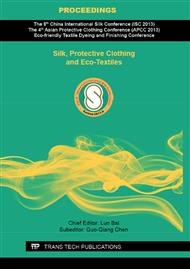p.488
p.492
p.497
p.502
p.507
p.513
p.519
p.523
p.527
Research on the Relationship between Color Thread Coverage Rate on the Surface of Yarn Dyed Fabric and its Color Saturation of Mixed Colors
Abstract:
In order to study the saturation control of space juxtaposition mixed colors of yarn dyed fabrics with different warp and weft colors, this paper takes the fabric variety with 6-color warp and 3-color weft for example, designed 7 kinds of weaves with gradual change of floating length with red, green and blue and makes them into fabric samples; then, puts forward the methods of posterization of digital fabric pictures and histogram statistics for counting the coverage rate of color thread on yarn dyed fabric surface, through which a more accurate result can be obtained than theoretical calculation; In the end, conducts color test on 21 fabric samples with Digieye digital color measurement system, which shows that the saturation (C*) of mixed colors of fabric samples has a good linear relationship with the coverage rate of color thread on yarn dyed fabric surface, with the linear correlation coefficient of 0.90333.
Info:
Periodical:
Pages:
507-512
Citation:
Online since:
September 2013
Authors:
Price:
Сopyright:
© 2013 Trans Tech Publications Ltd. All Rights Reserved
Share:
Citation:


